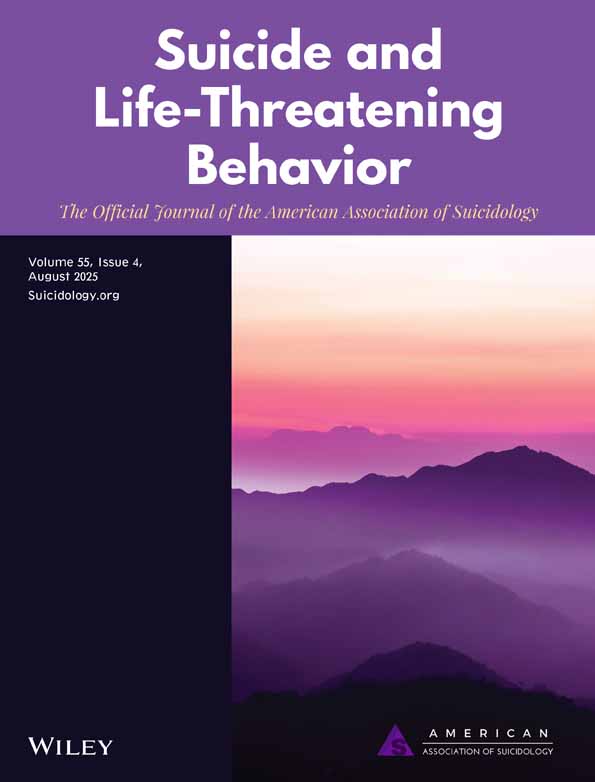Introduction
Durkheim defined suicide as “death resulting directly or indirectly from a positive or negative act of the victim himself, which he knows will produce this result” (Durkheim, 1897/1951). Deaths from self-inflicted injuries in the United States have increased steadily since the 1950s, making suicide the eighth leading cause of death in the 1980s (National Center for Health Statistics, 1987). As a cause of years of potential life lost, however, it ranks fourth (Centers for Disease Control, 1988). The rates of suicide increase in successive age groups from approximately 12 per 100,000 in the 15–24 cohort to 24 per 100,000 in those aged 75–84 (National Center for Health Statistics, 1987). It is the third leading cause of death among persons aged 15–24. The majority of completed suicides in all age groups are committed by white males; the majority of suicide attempts occur among white females.
Since Durkheim's seminal work in the late 19th century, and despite varying methodologies, certain risk factors have emerged that have consistently been associated with suicide and suicidal behaviors across a wide array of both clinical and epidemiologic studies. These include psychiatric disorder, sociodemographic risk factors, family history of suicide, biochemical risk factors, substance abuse, contagion, and firearms.
In the early 1970s, the field of suicide research was plagued by a lack of agreement on definitions of critical terms, inconsistent use of unstandardized measures, inadequate research designs and methods, and the absence of a solid empirical basis for early detection and prevention efforts. In the mid-1970s, an important book appeared in which leading investigators who had been brought together in conference by the National Institute of Mental Health (NIMH) attempted to remedy the situation. They critiqued existing research methods, and proposed various models for the measurement and prediction of suicide and suicidal behaviors (Beck, Resnik, & Lettieri, 1974).
Since that time there has been a new cycle of social crisis, led, in part, by media attention to the clustering of youth suicides and increased public awareness of the fact that the youth suicide rate has nearly tripled since the 1950s. With the aging of the population has come a greater appreciation of the high suicide rates in the elderly. The seriousness and saliency of the problem led to a Congressional mandate and earmarked monies for the study of suicide. In 1985, the Secretary of the Department of Health and Human Services created a Task Force on Youth Suicide and asked its members to synthesize available information and submit recommendations for action to both the public and private sectors. The results of those deliberations have recently been published (U.S. Department of Health and Human Services, 1988).
With so heavy a public demand for preventive intervention efforts and a consequent heightening of interest in research, it seemed timely to determine once again what progress was being made in this recalcitrant, complex, and extremely important area of research. In June 1987, NIMH's Division of Clinical Research convened a workshop titled “Strategies for Studying Suicide and Suicidal Behavior.” This was one of a series of program development activities designed to assess the current state of knowledge, inform the field, and stimulate research. The purpose of the Workshop was to examine some of the more promising methods and approaches being used to study suicide and suicidal behavior, with particular emphasis on different settings and populations. Participants were asked to characterize the findings in their special area of research and to critically review the strengths and weaknesses associated with the approach. They were also asked to identify questions or problems that require further study. The papers from that workshop are presented in this special issue of Suicide and Life-Threatening Behavior.
The workshop opened with a consideration of what can be learned from completed suicides—an assessment of the utility of mortality statistics and autopsy data. It then moves to approaches for investigating suicidal behaviors among inpatients and outpatients seen in hospitals and emergency rooms. Next came an examination of research on populations in community settings such as health centers, runaway shelters, and schools. This was followed by a review of community survey studies of suicidal behavior in the general population. This order is preserved in the present special issue.
There were some important gaps in the workshop. Approaches to studying suicide and suicidal behavior in the elderly, minorities, and AIDS victims were not on the agenda. These are high-risk groups that warrant a special focus and considerable research attention.
Although the workshop contributions do not constitute a comprehensive review of progress in research, they highlight major developments. The advent of biological approaches is noteworthy, as is the potential increase in diagnostic and predictive power that is evident when biological and psychological approaches are combined. There have been important advances and refinements in measurement techniques, and substantial movement toward agreement on operational definitions of critical terms. Our understanding of correlates and risk factors of suicide and suicidal behavior has clearly grown, moving us closer to developing and testing sensitive, ethical, and clinically effective interventions.
Progress can also be gauged by what problems remain. As the papers point out, we have not resolved the persistent problems of appropriate sampling, appropriate control or comparison groups, and issues of validity in the measurement of suicidal behaviors. In discussions,1 workshop participants identified several unmet needs. Among them was the need for prospective, collaborative, multisite studies, using standard operational definitions and assessments, and sharing a common protocol. There was also a call for more multidisciplinary cooperation that might bring together developmental, epidemiologic, clinical, and sociocultural perspectives.
We offer this volume in the hope that it will serve as a reference for investigators and promote good research. The content should also be of interest to clinicians, educators, and others concerned with suicide and suicidal behaviors.




